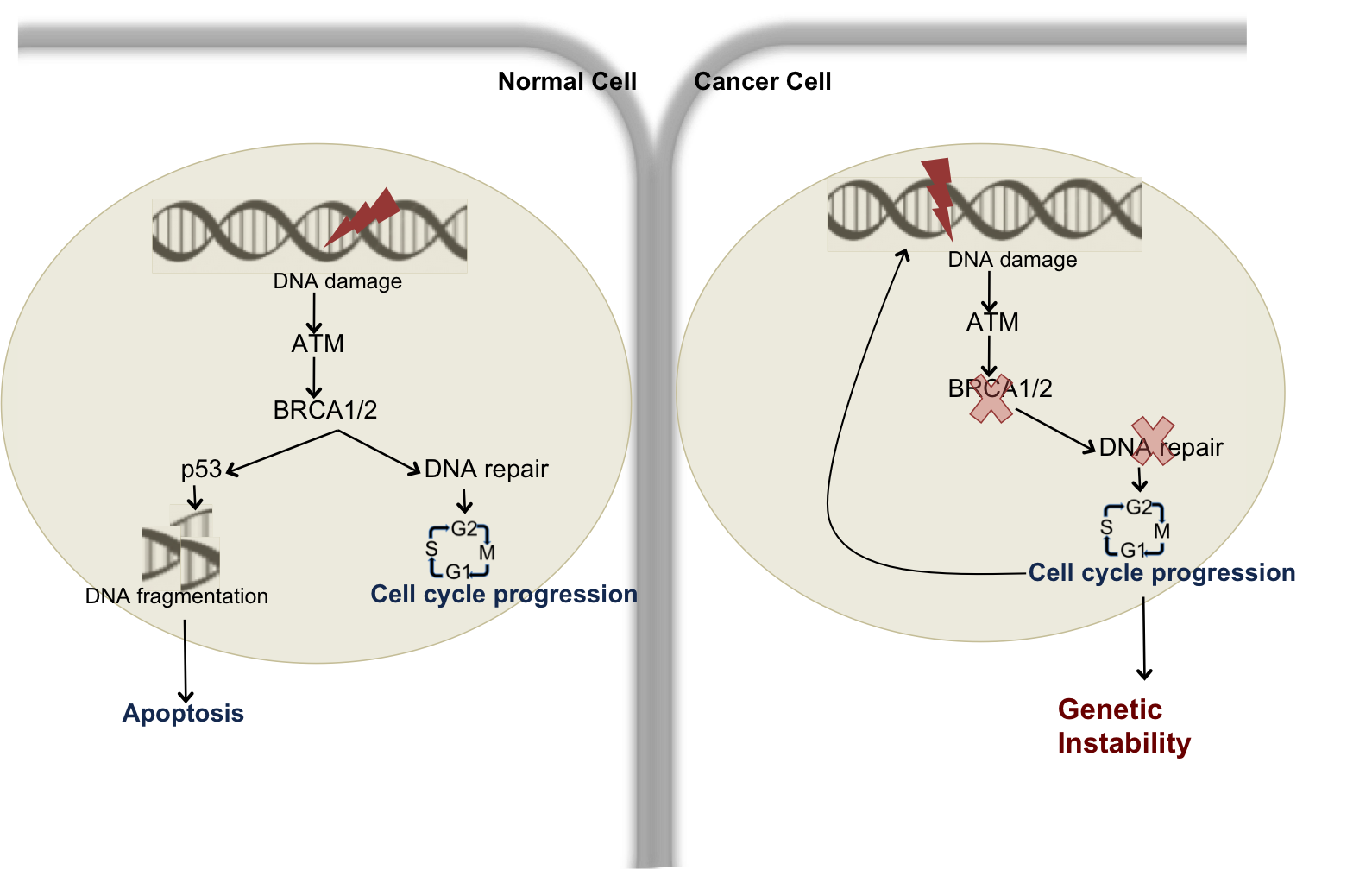Welcome to the final discussion on the defining
characteristics of cancer. As
we’ve discussed in parts 1 and 2 (Part1, Part2) cancer cells share several fundamental
traits which are outlined in the figure below.
Figure 1:
Hallmarks of Cancer
In this final discussion, we take a step back:
What allows cancer
cells to acquire these traits?
What allows cancer cells to tip the balance on all these processes
towards tumorigenesis? The answer
begins with the following two enabling hallmarks.
Genetic Instability
The acquisition of these 6 traits depends on a succession of
alterations in the genomes of cancerous cells. This increased susceptibility to genetic mutations is called
genetic instability. Normal cells
possess remarkable capability to detect and resolve any DNA damage and
mutations that might occur during cell division or through exposure to agents
that cause mutations such as UV light.
However, cancer cells have increased rates of mutations as well as
defects in the DNA damage sensors such that mutations go unchecked. The guardian of the genome, TP53, which
we have already encountered in its role as a tumor suppressor and in mediating
apoptosis, is also central in maintaining genomic integrity. Other caretaker genes include ATM and
BRCA1/2.
Figure 2: Caretakers of the Genome. When DNA damage occurs, including mutations, DNA strand breaks etc, proteins sensors in the cell such as ATM recognize the damage. If the damage is too severe, p53 is activated and the cell undergoes apoptosis, killing itself to prevent further damage. If the damage is reparable, BRCA1/2 are activated and the damage is repaired so the cell cycle can continue. In cancer cells that carry mutations in one of the caretaker proteins such as BRCA1/2, the damage is not repaired but the cell cycle continues, duplicating the mutation in daughter cells. Such mutations inevitably lead to the accumulation of additional mutations and genetic instability.
Figure 2: Caretakers of the Genome. When DNA damage occurs, including mutations, DNA strand breaks etc, proteins sensors in the cell such as ATM recognize the damage. If the damage is too severe, p53 is activated and the cell undergoes apoptosis, killing itself to prevent further damage. If the damage is reparable, BRCA1/2 are activated and the damage is repaired so the cell cycle can continue. In cancer cells that carry mutations in one of the caretaker proteins such as BRCA1/2, the damage is not repaired but the cell cycle continues, duplicating the mutation in daughter cells. Such mutations inevitably lead to the accumulation of additional mutations and genetic instability.
Tumor promoting inflammation
Like a bacterial infection, the presence of a tumor evokes
an immune response. When immune
cells gather around a neoplastic lesion, they produce an inflammatory response,
releasing bioactive molecules including growth factors to promote survival,
proangiogenic factors to allow the growth of blood vessels, and extracellular
matrix modifying enzymes to promote local invasion and metastasis. Furthermore, immune cells also release
chemicals such as reactive oxygen species which promote genetic instability. Because inflammation can be detected at
very early stages of tumor growth, researchers believe that this inflammatory
immune response actually promotes tumorigenesis and the acquisition of
additional tumor-bearing characteristics.
Figure 3: Tumor promoting inflammation. The presence of tumors can induce an inflammatory response by the immune system. Immune cells recruited to the tumor site release cyokines and growth factors that can act on the tumor cell, enabling proliferation, migration, and angiogenesis Additionally, the release of reactive oxygen species (ROS) can damage the DNA of cancer cells, leading to genetic instability.
Figure 3: Tumor promoting inflammation. The presence of tumors can induce an inflammatory response by the immune system. Immune cells recruited to the tumor site release cyokines and growth factors that can act on the tumor cell, enabling proliferation, migration, and angiogenesis Additionally, the release of reactive oxygen species (ROS) can damage the DNA of cancer cells, leading to genetic instability.
Where do we go from
here?
Congratulations Readers! You’ve completed your introduction to cancer biology! The 6
hallmarks of cancer and the two enabling traits comprise the foundation for
understanding cancer at its most basic level. You will see a lot of these characteristics and their key
signaling proteins in future blog posts as we explore more exciting cancer
research.
For your reference, I’ve created a new tab that highlights
the key proteins and their signaling pathways. You can find them here.
There’s a lot of information in these last three posts. Although every attempt was made to be
clear, it’s quite possible that some concepts aren’t fully understand. Do you have any questions? Is there something you’d like to know
more about? Let me know, and we
can discuss it further or we can develop a new blog entry.
The principle behind the hallmarks of cancer lies in the
ability of cancer cells to tip the balance between normalcy and tumorigenesis. With more research and better
treatments, we hope to tip the scale back towards cellular homeostasis.
References:
1. Hahahan D and Weinberg RA. Hallmarks of Cancer Cell. 2001;100:57-70.
1. Hahahan D and Weinberg RA. Hallmarks of Cancer Cell. 2001;100:57-70.
2. Hahahan D and Weinberg RA.
Hallmarks of Cancer: The Next Generation
Cell. 2011;144:646-74.


No comments:
Post a Comment